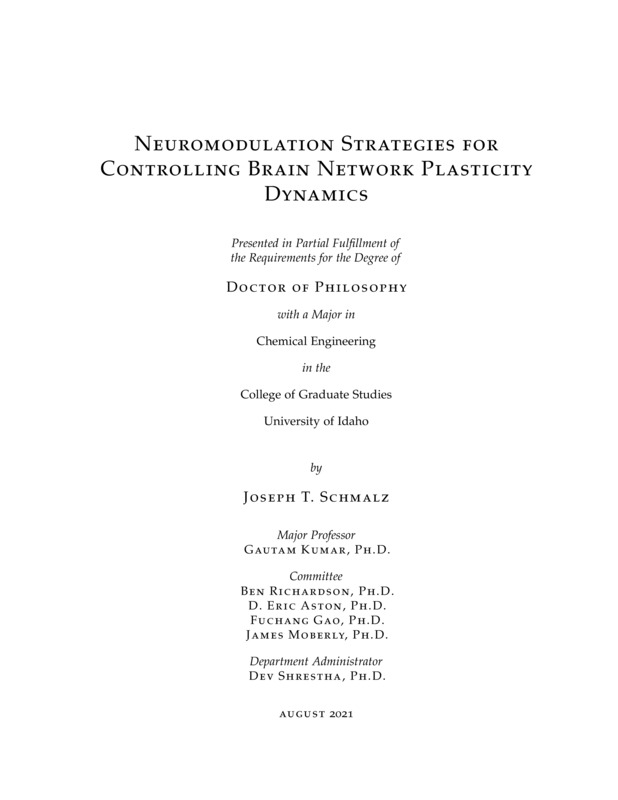Neuromodulation Strategies for Controlling Brain Network Plasticity Dynamics
Schmalz, Joseph. (2021-08). Neuromodulation Strategies for Controlling Brain Network Plasticity Dynamics. Theses and Dissertations Collection, University of Idaho Library Digital Collections. https://www.lib.uidaho.edu/digital/etd/items/schmalz_idaho_0089e_12185.html
- Title:
- Neuromodulation Strategies for Controlling Brain Network Plasticity Dynamics
- Author:
- Schmalz, Joseph
- ORCID:
- 0000-0001-9723-4919
- Date:
- 2021-08
- Keywords:
- Desynchronization FTSTS Neuromodulation Plasticity SC-CA1 Synchronization
- Program:
- Chemical and Materials Science Engineering
- Subject Category:
- Chemical engineering
- Abstract:
-
Neuromodulation refers to a broad term for perturbing the brain states using either external electrical stimulation, optical stimulation, a drug, or a combination of all. In recent years, neurostimulation, a paradigm for perturbing the brain states electrically or optically, has emerged as a promising approach for investigating basic neuroscience questions and developing therapies for various brain disorders such as Parkinson’s disease, epilepsy, major depressive disorders, and Alzheimer’s disease. However, most of the existing neurostimulation-based therapies for brain disorders focus on suppressing symptoms and ignore the dynamical aspects of the underlying network that create the pathological symptoms. As a result, the symptoms of specific disorders reemerge once the external stimulation turns off. Based on the evidence of the plastic nature of brain circuits in many areas of the brain, this dissertation investigates novel neuromodulation strategies to achieve long-term changes in the brain states by harnessing brain network’s plasticity. In the first part of this dissertation, a unified multi-timescale computational modeling framework is developed to investigate drug-based neuromodulation strategies for modulating synaptic plasticity dynamics in the hippocampus and basal ganglia circuits for potential applications in developing therapies for stress-mediated brain disorders and Parkinson’s disease. The second part of the dissertation focuses on developing electrical stimulation strategies for controlling synchronization of neuronal activity in large-scale brain networks by harnessing synaptic plasticity for potential applications in suppressing epileptic seizures and pathological synchronization in Parkinson’s disease.
- Description:
- doctoral, Ph.D., Chemical and Materials Science Engineering -- University of Idaho - College of Graduate Studies, 2021-08
- Major Professor:
- Kumar, Gautam
- Committee:
- Richardson, Ben; Aston, D. Eric; Gao, Fuchang; Moberly, James
- Defense Date:
- 2021-08
- Identifier:
- Schmalz_idaho_0089E_12185
- Type:
- Text
- Format Original:
- Format:
- application/pdf
- Rights:
- In Copyright - Educational Use Permitted. For more information, please contact University of Idaho Library Special Collections and Archives Department at libspec@uidaho.edu.
- Standardized Rights:
- http://rightsstatements.org/vocab/InC-EDU/1.0/

